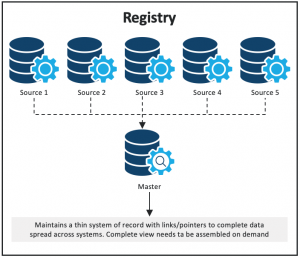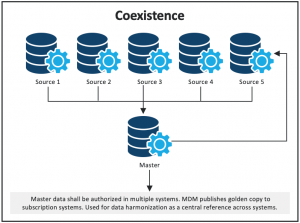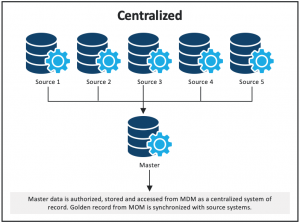Today’s business depends on transaction processing, and BI and Analytics increasingly drive marketing campaigns, customer engagement, supply chain management, and other business processes. But, many companies doesn’t have a single view of their customers to transform into a great customer experience with potential data management and governance.
Let’s look into some of the major challenges with data management and governance and how Master Data Management (MDM) can help resolve;
Data Quality, Accuracy, and Consistency
Ensuring data quality, accuracy, and consistency are the biggest challenges for any business. Data quality issues can arise from various levels, such as human errors, similar data from different sources, incomplete or inconsistent data, etc., impacting businesses with their customer experience and decision-making.
Data Security
Improper data ingestion can lead to unreliable connectivity, resulting in data modification or loss of data. Organizational data, which holds personal, financial, confidential, or proprietary information, is always sensitive and critical for business. This data can be put to risk due to internal or external sources like security breaches, hackers, malware programs, or human errors.
Data Reliability and Complexity
Data silos, redundancy, and inconsistency generally occurs when ingestion happens from various forms of data from multiple sources. Data stored in different systems, databases, applications, and platforms triggers several integration and data reliability issues, affecting operational efficiency and business performance.
Data Governance and Alignment
Lack of data governance for master data is proportionate to non-alignment with business goals and strategies. Aligning the data with governance and customer needs pave the way for better performance and extreme customer satisfaction.
Data Evolution and Innovation
Data has been evolving with various innovations and transformations, leading to challenges as well as opportunities. To adapt and overcome these challenges, fostering a data-driven culture that integrates data sources, technologies, and solutions like cloud, big data, artificial intelligence, and blockchain is needed.
Importance of MDM in Ensuring Data Quality
The MDM solution encompasses a range of transformations, data cleansing, and integration practices. Whenever data from different sources added to a system, MDM initiates processes to identify, collect, transform, and repair the data.
When the data faces any quality thresholds, we ought to maintain a high-quality standard master data reference with the help of schemas and taxonomies. MDM helps organizations feel safe and relaxed about the accuracy and consistency of the data at the enterprise level.
Many countries and jurisdictions are creating privacy laws, impacting companies or businesses in those locations. The result of the increased survey is dependent on master data management solutions.
Overcoming the Complexities of Data Management and Governance with MDM
What is MDM?
MDM involves creating uniform sets of data on customers, products, and other business entities. The data is re-duplicated, reconciled, and enriched, making it a consistent, reliable source. Once created, this master data serves as a trusted view of all business-critical data that can be managed and shared across the business, promoting accurate reporting, reducing data errors, removing redundancy, and enabling informed decision-making.
Among the many softwares available to automate MDM tasks from various vendors, Informatica stands as a leading industry enterprise cloud data management and data integration products provider. Informatica MDM solutions help organizations acquire a single view of their products and customers. MDM software helps resolve business issues that emerge due to imprecise data by incorporating data stewardship and data governance features with supportive tools.

MDM Architecture
MDM architecture helps customers to understand the company’s product offerings like Federation, Integration, Networks, Mining, Virtualization, Visualization, File Systems, Marts, Warehouse, Lakes, and Operational Data Stores. This architecture can be structured in different ways depending on the organization’s requirements. The MDM programs can be structured, built, and connected with MDM hub and various source systems.
MDM architectural styles can be classified into four categories,
 Registry Architecture
Registry Architecture
This architecture creates a unified master data without changing individual source systems data for analytical uses. It can be considered as the most lightweight MDM architecture as it uses tools for data cleansing and matching to identify duplicate data in different systems and cross-refer them in the registry.
 Consolidation Architecture
Consolidation Architecture
This architecture consolidates the master data sets in MDM hub pulled from various source systems by creating a centralized repository primarily used for business intelligence analytics and enterprise reports. On the other side, all operational systems continue to use their own master data for transactional processing.
 Coexistence Architecture
Coexistence Architecture
This architecture consolidates the master data sets in MDM hub pulled from various sources by creating a centralized repository. In this architecture, any changes to the master data in individual source systems are updated in the hub and propagated to other systems, so they all use the same data, offering a balance between system-level management and centralized governance of master data.
 Centralized Architecture
Centralized Architecture
This architecture is also known as Transaction Architecture. Whenever each source changes are published, this architecture helps to move to MDM hub for easier maintenance and management. It’s the most intrusive architecture of MDM from an organizational perspective because of the shift to full centralization. Besides a master data storage repository and software to automate the interactions with sources, an MDM framework typically includes change management, workflow, and collaboration tools. With MDM hub set up, data virtualization software can create unified views from various systems without building a physical data model.
Core Features of MDM
Below are some important features of MDM,
- Data-as-a-service
- 3rd party system integrations with high scalability
- 360-degree view between customers, products, suppliers, and other relational entities
- Pre-built data models and accelerators
- Intelligent search capabilities
- Intelligent matches and merges property
- It has intelligent security
- Modular design
There are a few subsets of MDM, and they are as follows,
Metadata Management
Metadata management is used to manage data with data and about data. It helps organizations to,
- Ensure compliance
- Identify and locate a specific data asset
- Manage the risks
- Make sense of data
- Perform analytics of the data in multiple data sources inside and outside
Metadata management is becoming more important as organizations are extending to the Internet of Things (IoT) and third-party data sources with a continuous increase in the volume of data.
Product Information Management (PIM)
PIM is another important aspect and subset of MDM. It is a process of collecting, managing, and enriching product information, led by business users. PIM creates a single source of truth for product information, so sales, marketing, and data governance teams frequently use it.
MDM Implementation and Benefits
Master Data Management can be implemented for analytical purposes to support data warehouses, data lakes, and analytic systems, or for operational purposes to support core business systems. Both Analytical MDM and Operational MMD approaches provide a systematic master data management, enabling a centralized MDM hub deployment where the master data is stored, monitored, and maintained.
MDM implementation follows an appropriate flow of analyzing and understanding the business processes, identifying the domain to set up a master domain platform, specifying several use cases, and listing and reviewing the current and future performance metrics, eventually determining the scope.

We looked at some of the challenges above, and let’s see how they can be resolved with a proper implementation of MDM strategy,
- Establish and enforce data quality standards, policies, procedures, and use DQ tools to monitor, measure, and improve your data
- Establish data security measures like encryption, authentication, authorization, backup and recovery, data privacy and security compliance
- Establish single source of centralized data repository to eliminate data silos, reduce data redundancy, improve data consistency and reliability. Also, it helps optimize business processes, workflows, and systems while improving operational efficiency and agility
- Establish a data governance framework by identifying right source of data, and integrate, harmonize, and synchronize with appropriate reconciliation to yield organization data and support their business objectives with regulatory compliance
- Establish a business initiative to eliminate cost redundancies, better customer and product experience, easier mergers and acquisitions, effective governance and compliance, improve operational efficiency and supplier optimization
- Establish an MDM architecture to benefit data stewards, specialists, executive sponsors, business stakeholders, and management
MDM Framework
An MDM framework is critical for an effective data management strategy. MDM framework outlines best practices, disciplines, and values to guide master data management and governance. These practices ensure the accuracy and consistency of the shared master data. The elements of an MDM framework are as follows,
- Data Governance
- Data Measurement
- Data Stewards
- Data Process
MDM Software Capabilities
MDM helps businesses make informed decisions with integrity, accuracy, and data visibility. The core capabilities of MDM that enable the best decision-making possible are as follows,
- Data Profiling
- Data Matching
- Data Linking
- Data Business Rules
- Data Democratization
- Data Localization
- Data Security and Privacy
- Data Delivery and Enrichment
A Modernized Cloud Platform
Informatica’s Master Data Management (MDM) is an industry-first cloud-native platform designed to help businesses efficiently handle the complex challenges of dispersed and fragmented data to truly innovate with their data on virtually any platform, any cloud. A contextual 360-degree view and insights with Informatica Intelligent Master Data Management (MDM). It includes features such as,
- Deploy faster with all-in-one capabilities and pre-built domain and industry content
- Democratize your master data with self-service access and AI-powered automation
- Connect multiple domains into an enterprise-wide business
- Cloud-native solution for quality, integration, and governance
- Self-service with business-oriented UI and automation
- IMDM is a no-code, low-code platform with a GUI interface and template wizards
- Data integration and cleansing are all managed, including checking for duplicate records, verifying customer data format, mapping and detecting addresses, etc. It saves developers months in data wrangling, ultimately empowering them to focus on more innovative activities
- Metadata components are organized into knowledge graphs, where any team can easily perform machine learning with complete characteristics, associations, relationships, and hierarchies at ease
- Enterprise Data Governance plays a vital role. Data Security and trust are built-in as design principles with features such as,
-
- Complete Lineage of Data
- Framework for Data Governance
- Glossary of Terms
- Data Access Visibility and cataloging






Thank you for this article. It is well written with detailed explanation.
It did help me understand MDM concepts.